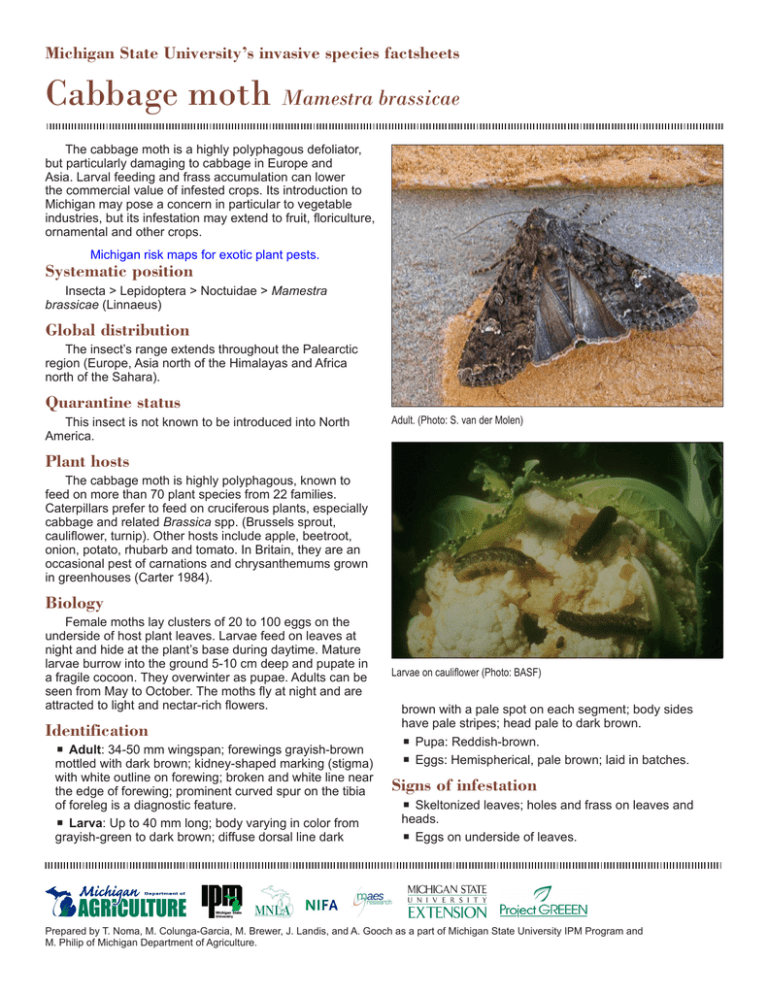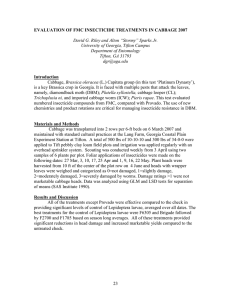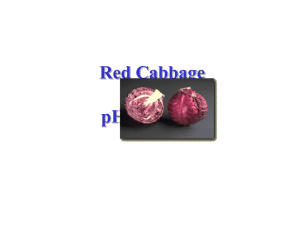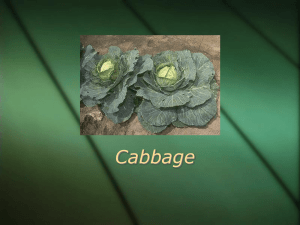Cabbage moth Mamestra brassicae Michigan State University’s invasive species factsheets
advertisement

Michigan State University’s invasive species factsheets Cabbage moth Mamestra brassicae The cabbage moth is a highly polyphagous defoliator, but particularly damaging to cabbage in Europe and Asia. Larval feeding and frass accumulation can lower the commercial value of infested crops. Its introduction to Michigan may pose a concern in particular to vegetable industries, but its infestation may extend to fruit, floriculture, ornamental and other crops. Michigan risk maps for exotic plant pests. Systematic position Insecta > Lepidoptera > Noctuidae > Mamestra brassicae (Linnaeus) Global distribution The insect’s range extends throughout the Palearctic region (Europe, Asia north of the Himalayas and Africa north of the Sahara). Quarantine status This insect is not known to be introduced into North America. Adult. (Photo: S. van der Molen) Plant hosts The cabbage moth is highly polyphagous, known to feed on more than 70 plant species from 22 families. Caterpillars prefer to feed on cruciferous plants, especially cabbage and related Brassica spp. (Brussels sprout, cauliflower, turnip). Other hosts include apple, beetroot, onion, potato, rhubarb and tomato. In Britain, they are an occasional pest of carnations and chrysanthemums grown in greenhouses (Carter 1984). Biology Female moths lay clusters of 20 to 100 eggs on the underside of host plant leaves. Larvae feed on leaves at night and hide at the plant’s base during daytime. Mature larvae burrow into the ground 5-10 cm deep and pupate in a fragile cocoon. They overwinter as pupae. Adults can be seen from May to October. The moths fly at night and are attracted to light and nectar-rich flowers. Identification Adult: 34-50 mm wingspan; forewings grayish-brown mottled with dark brown; kidney-shaped marking (stigma) with white outline on forewing; broken and white line near the edge of forewing; prominent curved spur on the tibia of foreleg is a diagnostic feature. Larva: Up to 40 mm long; body varying in color from grayish-green to dark brown; diffuse dorsal line dark Larvae on cauliflower (Photo: BASF) brown with a pale spot on each segment; body sides have pale stripes; head pale to dark brown. Pupa: Reddish-brown. Eggs: Hemispherical, pale brown; laid in batches. Signs of infestation Skeltonized leaves; holes and frass on leaves and heads. Eggs on underside of leaves. Prepared by T. Noma, M. Colunga-Garcia, M. Brewer, J. Landis, and A. Gooch as a part of Michigan State University IPM Program and M. Philip of Michigan Department of Agriculture. Cabbage moth 2 Larva and frass. (Photo: Coutin R. OPIE) Cabbage damaged by cabbage moth larvae. (Photo: Groene savooiekool schade van kooluil) Eggs on a cabbage leaf (Photo: Coutin R. / OPIE) Larvae feeding on the plants at night. Management notes Sex pheromones for the cabbage moth have been identified (http://www.nysaes.cornell.edu/fst/faculty/ acree/pheronet/ins/mamesbrass.html). Control measures include autumn plowing, eradication of weeds, release of Trichogramma parasitoids, insecticide treatments targeting defoliating larvae (Ovsyannikova and Grichanov). Economic significance to Michigan The cabbage moth is a polyphagous defoliator that potentially poses a risk to a variety of agricultural, nursery, and ornamental plant productions in Michigan (see also other noctuids of concern: links to Egyptian cottonworm, golden twin spot, Old World bollworm, Oriental leafworm, silver Y moth). The caterpillars may destroy a large number of leaves and their frass accumulates in the heart of cabbage. Once established, eradication of this insect may be difficult because of its adaptability to a wide range of climatic conditions, a wide host range, and nocturnal feeding habits. Likely pathways of entry in Michigan Live plant imports from Asia and Europe. ***If you find something suspicious on a susceptible host plant, please contact MSU Diagnostic Services (517355-4536), your county extension office, or the Michigan Department of Agriculture (1-800-292-3939).*** References Anonymous. 2008. Butterflies and moths of Northern Ireland: Cabbage moth. (http://www.habitas.org.uk/moths/species.asp?item=6245) Carter, D. J. 1984. Pest Lepidoptera of Europe with special reference to the British Isles. Dr W. Junk Publishers. Dordrecht, the Netherlands. Ovsyannikova, E. I. and I. Ya. Grichanov. Interactive agricultural ecological atlas of Russia and neighboring countries: Mamestra brassicae L. – cabbage moth. (http://www.agroatlas.ru/en/content/pests/Mamestra_brassicae/) Witzgall, P., T. Lindblom, M. Bengtsson, M. Tóth. 2004. The Pherolist. February 2010. MSU is an affirmative-action, equal-opportunity employer. Michigan State University Extension programs and materials are open to all without regard to race, color, national origin, gender, gender identity, religion, age, height, weight, disability, political beliefs, sexual orientation, marital status, family status or veteran status. Issued in furtherance of MSU Extension work, acts of May 8 and June 30, 1914, in cooperation with the U.S. Department of Agriculture. Thomas G. Coon, Director, MSU Extension, East Lansing,MI 48824. This information is for educational purposes only. Reference to commercial products or trade names does not imply endorsement by MSU Extension or bias against those not mentioned.




